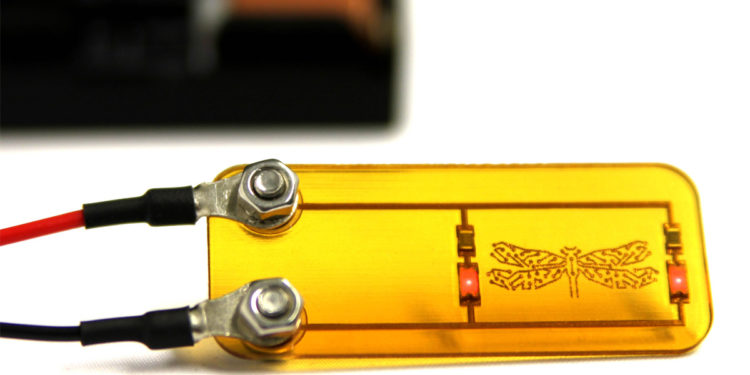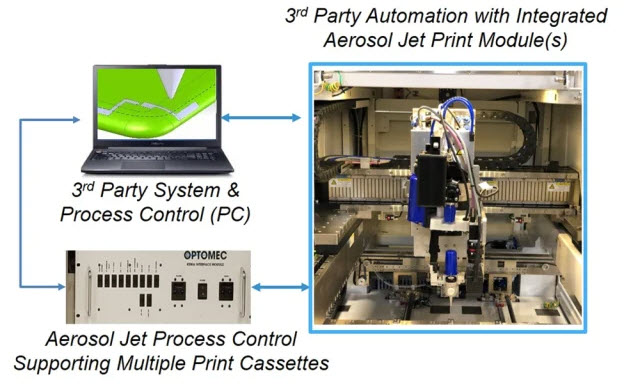
3D Printing of Electronic Components Creates New Manufacturing Possibilities
- Posted by doEEEt Media Group
- On May 6, 2021
- 0
Vincent Charbonneau provided an overview of 3D printing capabilities on engineering.com website. This overview complete the picture of article about 3D printed capacitors by Nano-Dimension 3D printer here.
As a technology, 3D printing has existed for longer than some might think. Also known as additive manufacturing, due to the fact that objects are printed by adding material layer by layer, 3D printing first came to prominence in the 1990s. Given the technology’s infancy at the time, it was most suitable for the creation of aesthetic reference models during a project’s rapid prototyping phase.
Since that time, 3D printing has matured to the point where complex electronic components like circuit boards can now be constructed entirely through the use of CAD models and specialized 3D printers.
3D Printing Electronic Components
While several methods exist for 3D printing electronic components, typically this is accomplished by utilizing a dual-material fused filament process with conductive thermoplastic filaments. These thermoplastic filaments are often made with copper, but occasionally carbon and graphene are used instead. The latter is more brittle than copper, however, and have a tendency to shatter when subjected to significant vibrations.
As with all 3D printing, a digital CAD model of the desired part must first be designed, as this will serve as the printer’s instruction model, providing it with all the dimensional data required to build the component. Once the printing process begins, a trace is created (sort of like a part’s “fingerprint”), and then the requisite materials needed for that specific part are added in layers.
One key challenge when it comes to 3D printing electronic components compared to other printing projects is the need to use wider and thicker traces to compensate for the fact that the conductive ink, paint or filament utilized to build the traces has a higher resistance than the copper that is commonly used.
Many companies have already made significant forays into overcoming the numerous challenges posed by 3D printing complex components, allowing them to produce systems that are increasingly scalable and efficient. One such company is Nano Dimension.
Nano Dimension’s flagship platform is its DragonFly Lights-Out Digital Manufacturing (LDM) system for electronic circuitry. DragonFly LDM integrates a precise inkjet deposition printer with dedicated nano-inks and 3D software to print electronic circuits such as printed circuit boards (PCBs), antennas, capacitors and sensors.
The DragonFly’s eponymous “Lights-Out” manufacturing system signifies that the device is designed to run 24/7 with little to no operator intervention. According to Nano Dimension, “In the case of additive manufacturing, LDM means DragonFly users can 3Dprint more functioning electronic circuitry faster, extending the DragonFly’s rapid prototyping capabilities beyond prototyping. Users can now 3D print one-off prototypes as well as low-volume manufacturing of printed electronics.”
Making use of two self-cleaning print heads, one for nano-silver conductive ink and the other for dielectric polymer ink, DragonFly LDM is able to concurrently print with both inks in a single print job. Nano Dimension’s Switch software also plays an important role by preparing electronic designs for printing.
Switch users can adjust many characteristics of a 3D file, such as layer thickness, conductor width, layer order, punching, rotation options, as well as the shape or object outline. In addition, the software helps optimize the printing process by maximizing the use of the printing surface.
“The DragonFly LDM is designed to help our customers prepare for Industry 4.0 and stay competitive in a world that demands electronic devices with increasingly sophisticated features. Like its predecessor, the DragonFly Pro, it’s the first of its kind on the market, carefully designed for both ease of use and even more agile, faster and affordable 3D printing of functional circuitry,” said Amit Dror, CEO and co-founder of Nano Dimension. “We’re confident that the LDM system will provide best-in-class additive manufacturing of printed electronics on the market, making it possible for companies to be more innovative, improve productivity and reliability, lower costs, and reduce time-to-market.”
Another company that has thrown its hat into the electronic 3D printing ring is Optomec, which is focusing its efforts on Aerosol Jet technology and has developed a 3D printer capable of printing interconnects, traces, and even passive and active components on 2D and 3D substrates.
Printers equipped with the Aerosol Jet 3D printing system are able to print on a multitude of substrates, including plastics, ceramics and metallic structures. In addition, Aerosol Jet printers can print conformal interconnects on 3D surfaces, eliminating the need for wire bonding (for instance, printing electrical connections on 3D stacked die or for LED chip fabrication).
In terms of emerging applications for its technology, Optomec hopes to one day add biological component printing to its printer’s list of capabilities. “The technology behind Aerosol Jet can print electronic and biological components onto 2D and 3D surfaces. By tightly integrating electronic circuitry with physical packaging, Aerosol Jet is fueling growth in new consumer and military applications where increased functionality in smaller spaces is a key driving factor,” the company stated.
All told, there are many advantages associated with 3D printing, some of which have already been discussed above. From mass customization, greater design freedom, tooling reductions and packing efficiencies, there is no shortage of benefits from 3D printing.
That is not to say that the technology is flawless—far from it. There are still many hurdles to overcome before 3D printing, especially the printing of complex components like PCBs, can really take off on a large scale. Currently, the 3D printing of electronics still has a high energy consumption when contrasted with traditional manufacturing systems, and the printing process itself can be quite slow. Furthermore, as more and more people gain access to sophisticated 3D printers and the less complex the process becomes, the more difficult it will be to stop the illegal manufacturing or “pirating” of proprietary technology.
3D printing has tremendous potential, and as the technology continues to be refined over time, there is little doubt that increasingly complex components—both organic and artificial—will be printed and produced on a mass scale. There may even come a day when advanced 3D printers become a common household staple, just like refrigerators or stoves. Until that day arrives, companies like Nano Dimension, Optomec and others will continue to push the boundaries of electronic manufacturing via 3D printing.
featured image source: Nano-Dimension
- Space-Grade components available for immediate delivery - April 10, 2025
- Managing EEE components for LEO and lower cost space missions - December 17, 2024
- Filtering Characteristics of Parallel-Connected Fixed Capacitors in LCC-HVDC - November 21, 2024





0 comments on 3D Printing of Electronic Components Creates New Manufacturing Possibilities